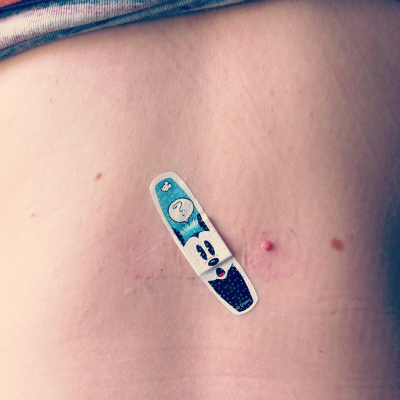Three weeks ago I had my twice-a year skin check with my dermatologist. Twice a year? you say? Yes, twice. I’m one of the lucky ones who gets to have every inch of my skin checked twice as often due to genetics and poor choices as a child.
While I’m not graced with an alabaster complexion, we can safely call my skin tone extra light beige. Pale skin might have been all the fashion at some point, but it doesn’t hold up well to sunlight. When I was a kid, even though my mom made sure there was a bottle of sunscreen in my bag when she dropped me off at the pool each day for summer break, I didn’t wear sunscreen. I also don’t tan easily, meaning I spent most of my summers in various phases of the burn and peel cycle. My nose was permanently red during the warmer months, and remains redder than my other skin from repeated burning.
And let’s not forget my teenage obsession with tanning beds. After all, everyone was doing it, and I didn’t want to be the palest girl at the prom. Thankfully, I was only allowed to tan right before prom and no other time.
So with that kind of history, I’m a heightened skin cancer risk. Before my most recent visit, seven suspicious moles have been removed over the years. (Seven? I think it’s seven. I’ve lost count, truthfully.) Of those, all but one of the biopsies came back as abnormal. Not cancer, but displaying the behavior of cells that could become malignant. I haven’t missed a single one of them.
I wasn’t that surprised, then, when my dermatologist took a close look at a spot that had been growing on my back and determined that it might be worth getting a tissue sample just to check it out. I never argue with her on this – if she thinks it warrants a sample, grab the lidocaine and scalpel and get to it.
The wait for the results is such a long wait. It takes about two weeks, but I didn’t hear anything back as the two week mark passed. I finally called yesterday to get my results. When they called me back, the triage nurse thankfully started with the most important part of the news: cancer-free.
Yay!
Then he started into a long explanation of how the pathology report showed that the cells did have an unusual behavior, could turn into cancer at some point, etc. I’ve heard it all before, and I’m a nurse so I understand the basics of skin cancer, but let him keep explaining it as if it was my first experience. He noticed my silence and asked if I understood. I replied, “Oh, yes, I understand. I’ve had several other moles removed that came back the same way.”
He laughed and asked why I didn’t stop him during his spiel if I was an old pro at this. I still like to hear the reassurance, and I need the reminder that a little mole can be abnormal but harmless at the moment and deadly later, so it’s good to stay vigilant about getting them checked.
The doctor didn’t take all of the edges of this one, so I have to go back under the knife in a month to remove more. I really don’t mind. Any mole she excises that is determined to be abnormal but cancer-free means we won that battle. Parts of my skin considered trying to kill me, but I cut them out before they had the chance to act. The (mutated cell) terrorists don’t win today.
I willingly show the tiny scars on my back, arms and abdomen to my kids, explaining why I have them and why it’s so important for them to be safe in the sun. My mom WAS right – I needed to wear sunscreen, and I’m dealing with the consequences of not listening to her. And I make sure my two girls wear sunscreen and hats as much as possible, too. They don’t like it, but it’s not nearly as uncomfortable as cleaning & caring for a hole in your skin where a suspicious mole used to be.
 What? You don’t have Mickey band-aids in your house?
What? You don’t have Mickey band-aids in your house?
I wear sunscreen regularly now. I try to respect my British Isles heritage and avoid the sun. And I monitor my skin for any changes – new moles, larger freckles, changes to shape or color, etc. (Which isn’t easy when I’m completely covered in them and can’t remember if that spot on my leg is new or I just forgot it was there.)
Too many people die from skin cancer, and it doesn’t have to be this way. Even if you can’t play connect the dots on every inch of your skin like I can, it’s still important to check your skin for any changes and make sure you see a dermatologist at least once a year for a screening.
Take five minutes to check your skin and set up a dermatologist appointment if it’s been awhile. Consider this your PSA for the week.






